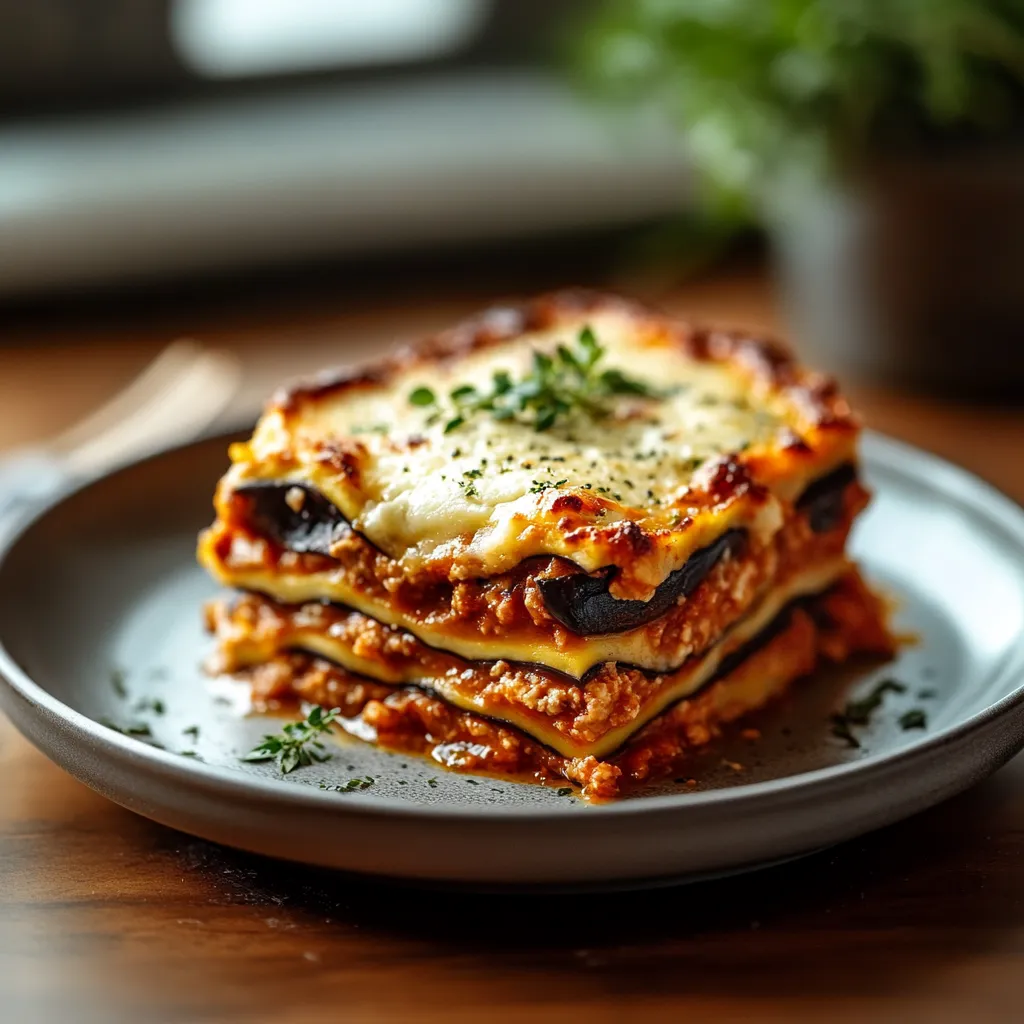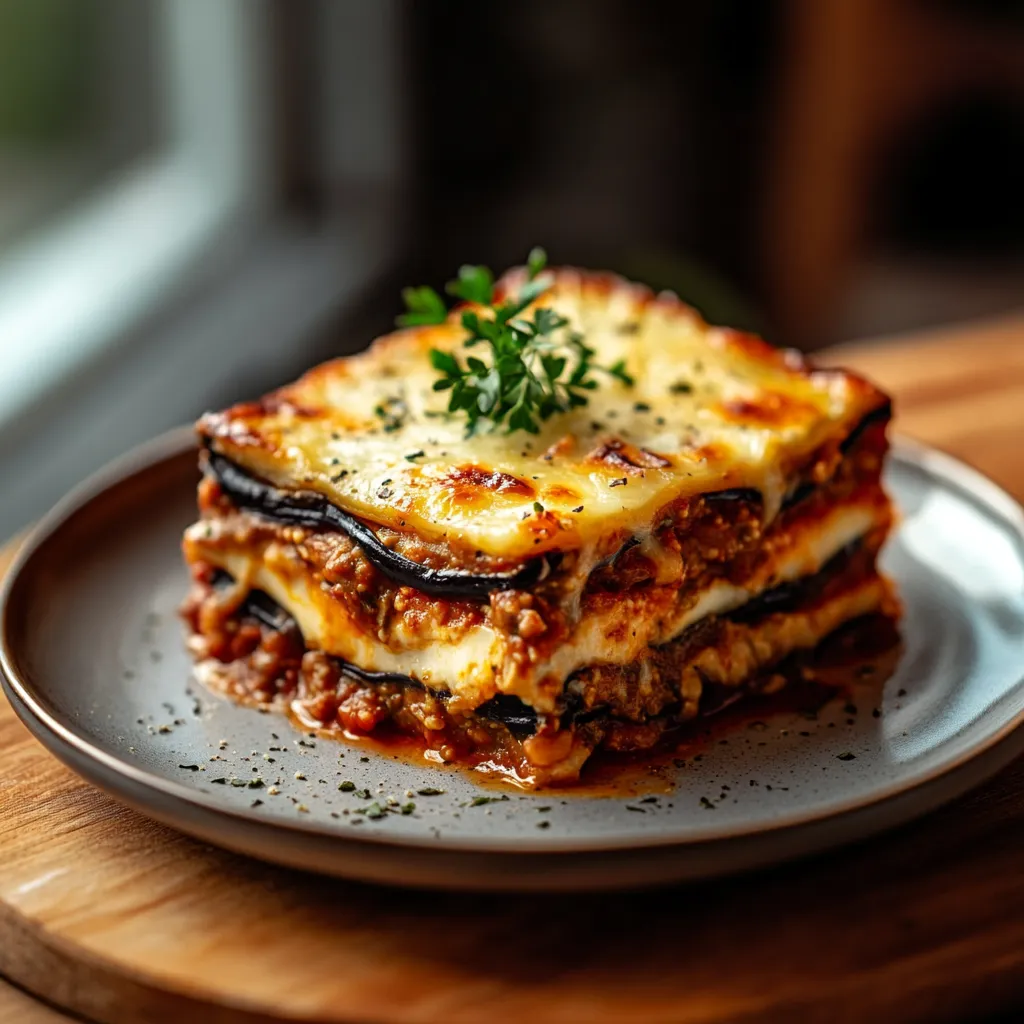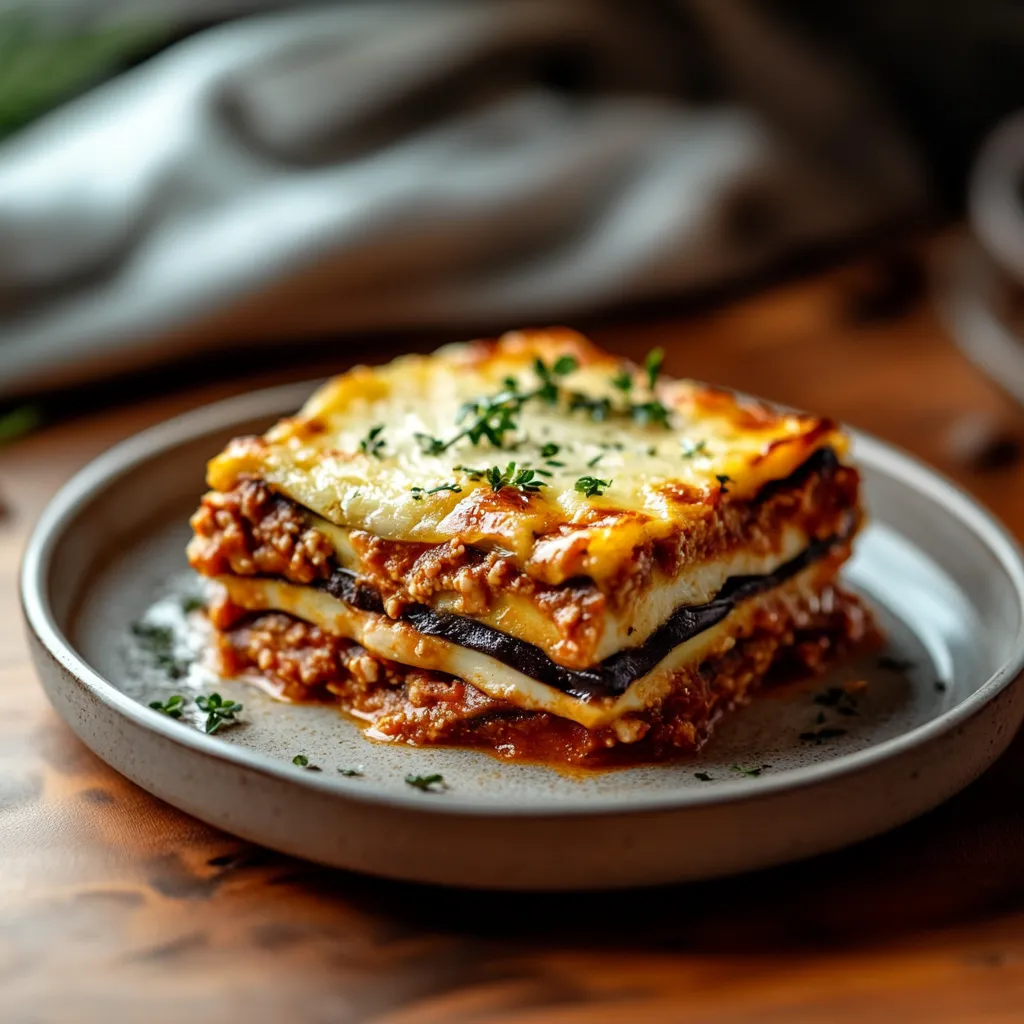 Pin it
Pin it
This classic Greek eggplant moussaka transforms humble ingredients into a comforting, layered masterpiece that transports you straight to a seaside taverna in Greece. The creamy béchamel crowns layers of tender eggplant and aromatic meat sauce, creating a dish that's impressive enough for company yet perfect for family dinners.
I learned this recipe during a cooking class in Santorini years ago, and it's become my go-to dish whenever I want to recreate those magical Greek vacation memories. My Greek-American neighbor once tasted it and declared it reminded her of her grandmother's version, which remains my proudest culinary moment.
Ingredients
- Eggplants: Select firm, glossy eggplants with smooth skin and substantial weight for their size. The freshest eggplants have bright green stems and feel heavy for their size.
- Ground beef or lamb: Lamb provides the most authentic flavor, but beef works beautifully too. Choose 80/20 meat for the best flavor and moisture.
- Onion and garlic: These aromatics create the foundation of the meat sauce. Look for firm onions without soft spots.
- Diced tomatoes: San Marzano variety offers excellent flavor, but any good quality canned tomatoes work well.
- Cinnamon: This warming spice is the secret signature flavor of Greek moussaka that distinguishes it from Italian dishes.
- Dried oregano: Greek oregano provides the most authentic flavor if you can find it.
- Butter: High quality European butter with higher fat content makes the richest béchamel.
- All purpose flour: The thickening agent for your béchamel sauce.
- Whole milk: Full fat milk creates the creamiest béchamel with the best flavor.
- Eggs: These enrich the béchamel and help it set properly when baked.
- Nutmeg: Freshly grated nutmeg offers vibrant flavor that elevates the béchamel.
Step-by-Step Instructions
- Prepare the Eggplant:
- Arrange eggplant slices on baking sheets and sprinkle generously with kosher salt. Let them sit for 30 minutes to draw out bitter juices. This step is crucial as it prevents the final dish from becoming watery and bitter. After 30 minutes, you will see small beads of moisture on the surface. Pat each slice thoroughly with paper towels until completely dry. Brush both sides with olive oil, arrange on baking sheets without overlapping, and roast at 400°F for exactly 20 minutes until they become golden but still hold their shape.
- Create the Meat Sauce:
- Heat a large, deep skillet over medium high heat until hot. Add the ground meat, breaking it into small crumbles with a wooden spoon. Cook without stirring too frequently to develop brown caramelization for about 5 minutes. Drain excess fat if needed, leaving about 1 tablespoon in the pan. Add the finely chopped onion to the browned meat and cook for 4 minutes until translucent but not brown. Add minced garlic and cook for just 30 seconds until fragrant, being careful not to burn it. Pour in diced tomatoes with their juice, then add oregano, cinnamon, salt and pepper. Reduce heat to medium low and simmer uncovered for 20 minutes, stirring occasionally. The sauce should reduce and thicken substantially. You know it's ready when a wooden spoon dragged through the sauce leaves a trail that slowly fills back in.
- Make the Béchamel:
- In a medium saucepan, melt butter over medium heat until it foams but doesnt brown. Sprinkle in flour and whisk continuously for 2 minutes to cook the raw flour taste away. The mixture should look like wet sand and smell slightly nutty. While whisking constantly, slowly stream in warm milk in small additions. Adding it gradually prevents lumps from forming. Continue whisking for 5 to 7 minutes as the sauce thickens enough to coat the back of a spoon. When you can draw a line through the sauce on the back of a spoon and it holds its shape, its ready. Take 1/4 cup of the hot sauce and slowly whisk it into the beaten eggs in a separate bowl to temper them. Then gradually whisk the egg mixture back into the sauce. Add nutmeg and salt, whisking to incorporate completely. The finished béchamel should be thick, glossy and smooth.
- Assemble and Bake:
- In a 9x13 inch baking dish, arrange half the roasted eggplant slices in an even layer, slightly overlapping if needed to cover the bottom. Spoon all of the meat sauce over the eggplant, spreading it into an even layer. Place remaining eggplant slices over the meat sauce. Pour the béchamel over everything, using a spatula to spread it into a smooth, even layer that completely covers the eggplant. Bake at 350°F for 45 minutes until the top is beautifully golden brown and bubbling around the edges. Let the moussaka rest for at least 15 minutes before cutting to allow the layers to set properly.
 Pin it
Pin it
My grandmother always said the secret to perfect moussaka is patience with the béchamel. She would stand at the stove slowly stirring for what seemed like an eternity, but that attention to detail makes all the difference. The warm scent of cinnamon in the meat sauce always transports me back to her kitchen in Athens.
Make-Ahead Tips
Moussaka is the ultimate prepare ahead dish and actually improves with time. You can assemble the entire dish up to 24 hours before baking and refrigerate it covered. Allow it to come to room temperature for 30 minutes before baking. Alternatively, bake the entire moussaka, cool completely, and refrigerate for up to 3 days. Reheat covered with foil at 350°F until warmed through, about 25 minutes.
Regional Variations
Every Greek family claims their moussaka recipe is the definitive version. In northern Greece, you'll find versions with sliced potatoes layered with the eggplant. On some islands, cooks add zucchini or even artichoke hearts. The Cypriot version includes sliced halloumi cheese between layers. Some modern Greek cooks even create vegetarian versions replacing the meat with lentils or mushrooms while maintaining the traditional spice profile.
Serving Suggestions
Moussaka is a complete meal in itself but pairs beautifully with simple sides. Serve with a crisp Greek salad dressed simply with olive oil and lemon juice. A crusty bread is perfect for sopping up the rich sauce. For wine pairing, a medium bodied red like Agiorgitiko from the Peloponnese region of Greece complements the dish beautifully. In summer, serve with a chilled rosé or light red slightly cooled.
 Pin it
Pin it
Moussaka delivers unforgettable layers of flavor that transport you to Greece—every bite is worth the effort!
Frequently Asked Questions
- → Can I make moussaka with pre-roasted eggplant?
Yes, you can use pre-roasted eggplant to save time. Make sure the eggplant is thoroughly cooked and not watery. Pat dry if necessary before layering to prevent excess moisture in the final dish.
- → Is it better to use lamb or beef in moussaka?
Traditionally, Greek moussaka uses lamb for its distinctive flavor that pairs beautifully with the warming spices. However, beef makes an excellent substitute that many prefer. For the most authentic flavor, try a 50/50 mix of lamb and beef.
- → Why do I need to salt the eggplant before cooking?
Salting draws out moisture and some of the natural bitterness from eggplant. This process helps the eggplant maintain its shape during baking and prevents the moussaka from becoming watery. It also allows the eggplant to absorb less oil during roasting.
- → Can moussaka be prepared in advance?
Yes, moussaka is excellent for make-ahead meals. You can assemble it completely, refrigerate unbaked for up to 24 hours, then bake when needed. Alternatively, bake it completely, cool, and refrigerate for up to 3 days before reheating. The flavors often improve with time.
- → Why did my béchamel sauce curdle?
Béchamel sauce typically curdles when eggs are added to a too-hot base or when heat is too high during cooking. To prevent this, ensure you temper the eggs by whisking a small amount of the hot sauce into them first, then gradually incorporate the egg mixture back into the sauce while continuing to whisk. Keep the heat low to medium.
- → What can I serve with moussaka?
Moussaka pairs beautifully with a simple Greek salad, crusty bread, or steamed vegetables. A side of tzatziki provides a cool contrast to the rich dish. For a complete Greek meal, serve with spanakopita (spinach pie) as a starter and baklava for dessert.
